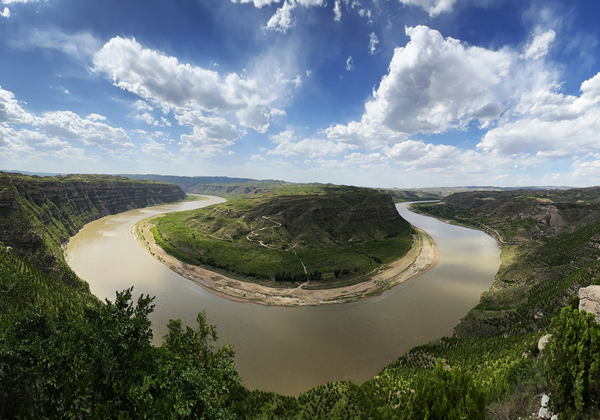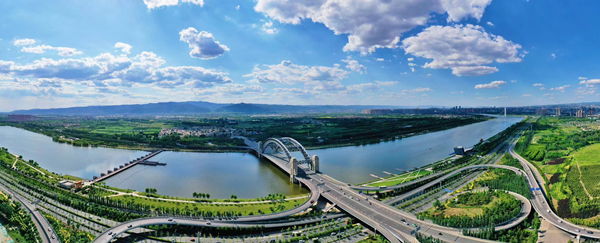Shanxi environmental project sets new standard
Updated: 2023-08-25

Tourists visit a sunflower farm in Guanjiabao township, Zuoyun county. [Photo by Ruan Yang for China Daily]
Protection of Lyuliang Mountains' ecology receiving direct support from State
Sustainable development is gaining traction in North China's Shanxi province after a key provincial environmental project was included in a national program and won strong financial support from the State.
The Lyuliang Mountain and Water Project, aimed at protecting the ecological environment of the western region of the Lyuliang Mountains, was included on June's national list of key integrated protection and restoration projects for mountains, rivers, forests, farmland, lakes, grasslands and sandy areas. It will receive 2 billion yuan ($275.15 million) of national financial support, according to an announcement by the Ministry of Finance on June 19.
Covering 14 counties, county-level cities and districts in the three prefecture-level cities of Lyuliang, Linfen, and Yuncheng, the project includes 62 subprojects, with a total investment of 5.51 billion yuan.
Zeng Bo, an official in charge of ecological restoration at the Shanxi Department of Natural Resources, said the provincial department has received the first allocation of funds, worth about 400 million yuan, from the Ministry of Finance and the money will be distributed to the 14 county-level locales after assessing their budgets. He said the significant support from the State will give a strong boost to the Lyuliang Mountain and Water Project.
"Upon its completion, we expect the project will increase the rate of soil erosion control by 10 percent, reduce the annual input of sediment into the Yellow River by 20 million metric tons, increase the area of forest and grassland by more than 3 percent, significantly enhance water conservation capacity and effectively protect biodiversity in the western part of the Lyuliang Mountains," Zeng said.
The ecological protection and restoration initiative is a crucial part of Shanxi province's efforts in curbing soil erosion and building a demonstration zone for the environmental protection and high-quality development of the Yellow River drainage basin.

Decades of soil erosion control has turned the Yellow River a cleaner river. [Photo provided to China Daily]
Located east of the Yellow River, the Lyuliang mountain range stretches about 400 kilometers in the west of Shanxi. The 5,464-km Yellow River, originating from Qinghai-Tibet Plateau and emptying into Bohai Bay, is the second-longest river in China.
The Shanxi section of the Yellow River is 965 km in length. More than 73.1 percent of the land in Shanxi, covering 114,600 square kilometers across 11 cities, is included in the river's drainage basin.
As Shanxi is located on the Loess Plateau, soil erosion has been a challenge to the ecological environment for thousands of years. In the early 1950s, the area of erosion in Shanxi was 108,000 sq km – more than half of which, or 67,600 sq km, was in the Yellow River drainage basin. Soil erosion-induced annual sediment in the river was 366 million tons during that period.
Shanxi launched its campaign to curb soil erosion in the 1950s and the pace has accelerated since 2012. After years of continuous efforts, 63 percent of the province's territory was freed from soil erosion by the end of 2022, according to the Shanxi Department of Ecology and Environment.
"The Lyuliang Mountains are a part of the Loess Plateau and many gullies in the mountains constitute the weakest link in local ecology," said Xue Xiangyang, mayor of Puxian, a county among the 14 locales for the Lyuliang Mountain and Water Project. "A majority of the silt sediments are washed away from the gullies, especially in flooding seasons.
"Engineering measures, such as building level terraces and works for gully head protection, proved to be successful in erosion control. This is especially true in the mountainous areas."
The mayor said he has met with county officials in charge of land resources, water resources, forestry and environmental protection to finalize a budget for soil erosion control, land greening and other ecological restoration projects.

The Fenhe River has witnessed an improving environment over the recent decades. [Photo by Li Zhaomin for China Daily]
Improvement of the Fenhe River is another important part of the local ecological protection and restoration program. The Fenhe is the second-largest river in Shanxi and the second-largest tributary of the Yellow River. It witnessed deterioration over the past century as a result of industrial pollution, decrease in water supply and reduction in vegetation coverage, but changes began to take place in the late 1990s.
The city of Taiyuan first launched an environmental improvement project for the river in 1998, with local authorities focusing their efforts on pollution control and increasing water supply to the river. This section of the Fenhe was initially revitalized in 2000 when water from an upper stream was continuously supplied to the main course in Taiyuan.
Other regions along the Fenhe followed Taiyuan's lead in taking action to improve the river, and Shanxi began a comprehensive environmental improvement program in 2017. A monitoring station at the Fenhe's estuary shows steady improvement in the river's water quality year-by-year. A rating below Class 4 has not been recorded at the station since June 2020, and 2022 statistics show the rate of Class 3 water quality reached 52.4 percent.
In China, Class 4 is the standard for water that can be used by industries and Class 3 is for water that can be used for irrigation and aquaculture. As a result of efforts to increase water supply and improve the environment, the Fenhe has once again become a scenic river with a pleasant environment.
In Shanxi, the improving ecological environment has brought visible benefits to residents.
Guanjiabao township in the northwestern Shanxi county of Zuoyun used to be one of the province's most challenging areas because of arid weather, but decades of greening efforts has transformed the township into an amiable place for residents and tourists alike.
Guanjiabao now boasts a vegetation coverage of 45 percent and has become a new check-in point for tourists thanks to its clear waters and green mountains near the Great Wall.
Kang Meixiang and Zhang Liyuan contributed to this story.



